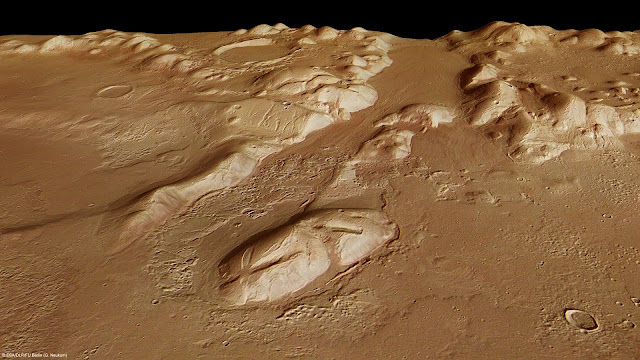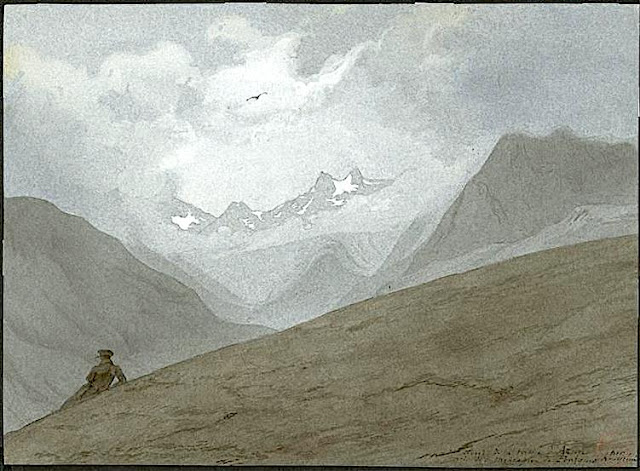EUGÈNE VIOLLET-LE-DUC (1814-1879)
Mont Valier (2,838m - 9,311ft)
France (Pyrénées)
In Vue du fond de la vallée d'Azun prise de la montagne de Pourges, Hautes-Pyrénées, watercolor, 1833
The mountain Mont Valier (2,838m - 9,311ft) is summit located in the Ariège Pyrenees, emblematic of Couserans, dominating the Angouls valley and its torrent, a short distance from the Spanish border.
The name comes from Valerius (Saint Valier, around 452), mythical first bishop of Couserans who would have climbed it. The Mont Valier belongs to the axial Pyrenean chain. Visible from afar, you can clearly see it from the plains of the Garonne and from Toulouse. The
summit is located within the perimeter of the regional natural park of
the Ariège Pyrenees. It is shared between the municipalities of Seix and
Bordes - Uchentein.
Several stone crosses have succeeded each other
at the top. If the first would have been the work of the first bishop of
Couserans Valerius in the 5th century, Bernard Coignet de Marmiesse,
another bishop of Couserans, had a marble cross erected there in the
1670s. The last was inaugurated in September 2012 after the destruction
by anticlerical vandalism in 2011 of the granite cross placed in 1987.
During the Second World War, an escape route from Saint-Girons to
Esterri d'Àneu in Catalonia crossed the Mont Valier massif to cross the
border at the difficult Col de la Pale de la Clauère. This "Chemin de la
Liberté" - the name given in 1994 to the long-distance footpath that
follows its route - allowed the escape of 782 people between 1940 and
1944 and remained operational, despite the increased surveillance of the
Germans from 1943 and the denunciations on the part of French
collaborators, and it functioned until the end of the war.
In 2000, a
via ferrata was created towards the Estagnous refuge (2,246 m). It
connects the refuge to the Long pond. Overlooking the round pond, it
allows you to discover verticality in safety and a quality point of
view. A departure is possible from the refuge or the Long pond. The
route totals a length of 1,200 m, including 620 m equipped, for a
one-way duration of 2 h 30 and 150 m of elevation. She is rated D.
By
ministerial decree of July 5, 2005, a vast territory located in the
municipality of Seix, including the national reserve of Mont Valier —
created in 1937 (it is one of the oldest in the Pyrenees) — as well as
almost all of the national territory of the Fonta massif, has been
classified as a site of the Natura 2000 network (special protection area
of the Mont Valier massif)
The access routes are only on foot and
for experienced and well-equipped hikers. The main access is from the
Riberot valley, in the commune of Bordes-Uchentein, from the Plat de la
Lau car park and via the Estagnous refuge (guarded in the right season,
reservation required).
The artist
Eugène Emmanuel Viollet-le-Duc (not to be confused with the french writer Violette Leduc!) was a French architect and theorist, famous for his "restorations" of medieval buildings. But he was, as well, an excellent but less famous watercolorist, sketching quite a number of mountains and volcanoes all over Europe.
Born in Paris, he was a major Gothic Revival architect. His works were largely restorative and few of his independent building designs were ever realised. Strongly contrary to the prevailing Beaux-Arts architectural trend of his time, much of his design work was largely derided by his contemporaries. He was the architect hired to design the internal structure of the Statue of Liberty, but died before the project was completed.
During the early 1830s, a popular sentiment for the restoration of medieval buildings developed in France. Viollet-le-Duc, returning during 1835 from study in Italy, was commissioned by Prosper Mérimée to restore the Romanesque abbey of Vézelay. This work was the first of a long series of restorations; Viollet-le-Duc's restorations at Notre Dame de Paris with Jean-Baptiste Lassus brought him national attention. His other main works include Mont Saint-Michel, Carcassonne, Roquetaillade castle and Pierrefonds.
Viollet-le-Duc's "restorations" frequently combined historical fact with creative modification. For example, under his supervision, Notre Dame was not only cleaned and restored but also "updated", gaining its distinctive third tower (a type of flèche) in addition to other smaller changes. Another of his most famous restorations, the medieval fortified town of Carcassonne, was similarly enhanced, gaining atop each of its many wall towers a set of pointed roofs that are actually more typical of northern France. Many of these reconstructions were controversial. Viollet-le-duc wanted what he called ‘a condition of completeness' which never actually existed at any given time. This approach to restoration was particularly problematic when buildings survived in a mixture of styles. For instance, Viollet-le-Duc eliminated eighteenth-century additions to Notre Dame. Both his theory and his practice were strongly criticized on the grounds that only what had once been in place should be reconstructed. At the same time, in the cultural atmosphere of the Second Empire theory necessarily became diluted in practice: Viollet-le-Duc provided a Gothic reliquary for the relic of the Crown of Thorns at Notre-Dame in 1862, and yet Napoleon III also commissioned designs for a luxuriously appointed railway carriage from Viollet-le-Duc, in 14th-century Gothic style.
Among his restorations were:
- Churches :
Notre-Dame in Paris, Abbey of the Mont Saint-Michel, Basilica of St. Mary Magdalene in Vézelay, St. Martin in Clamecy, Sainte-Chapelle in Paris, Basilica of St. Denis near Paris, St. Louis in Poissy, Notre-Dame in Semur-en-Auxois, Basilica of St. Nazarius and St. Celsus in Carcasonne, Basilica of St. Sernin in Toulouse, Notre-Dame in Lausanne (Switzerland).
Town halls:
- Saint-Antonin-Noble-Val, Narbonne
Castles:
- Château de Roquetaillade in Bordeaux, Château de Pierrefonds, Fortified city of Carcassonne, Château de Coucy, Antoing in Belgium, Château de Vincennes in Paris.
When monuments was to much damaged, he sometimes obtain from the emperor Napoleon III the permission to entirely rebuilt it, like he did in Avignon with the Popes ramparts all around the city.
_______________________________
2022 - Wandering Vertexes...
by Francis Rousseau

%20-%20Acropolis%20-%20Parthenon_(1871)_MET%20new%20Yprk.jpg)
)%20-%20Petersfelsen%20bei%20Beuron-%20(Upper%20Danube%20Valley,%20Baden-Wu%CC%88rttemberg),922,%20oil%20on%20cardboard%20.png)
-%20Cirque%20de%20BArrosa-%20Pyre%CC%81nne%CC%81es.jpg)


%20-%20Glen%20Helen-%20watercolor.jpg)


-%20Wudangshan%20(X),%20lavis,%202018,%2028x38cm.png)
%20-San%20Miniato%20Hills%20(%20140m)%20,%201892,%20huile%20sur%20toile%2022x48,c%20cm-%20CP%20New%20York%20.png)
%20-%20The%20MOnt%20Blanc%20%20seen%20from%20italy%20%20oil%20on%20canvas,%20100%20x%20140-CP%20.jpg)
-%20Casthill%20Mountain%20House%20,%20The%204%20elements%201843-44.png)

%20%20-%20%20Purple%20Mountains,%20Vence%20-%20Phoenix%20Art%20Museum%20.jpg)



-%20Indonesian%20mountians.JPG)
